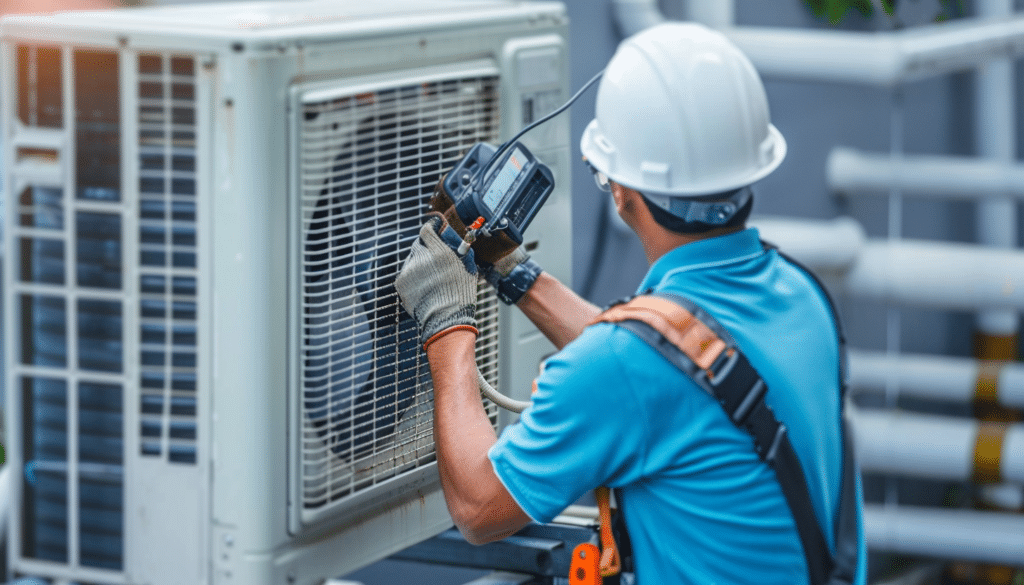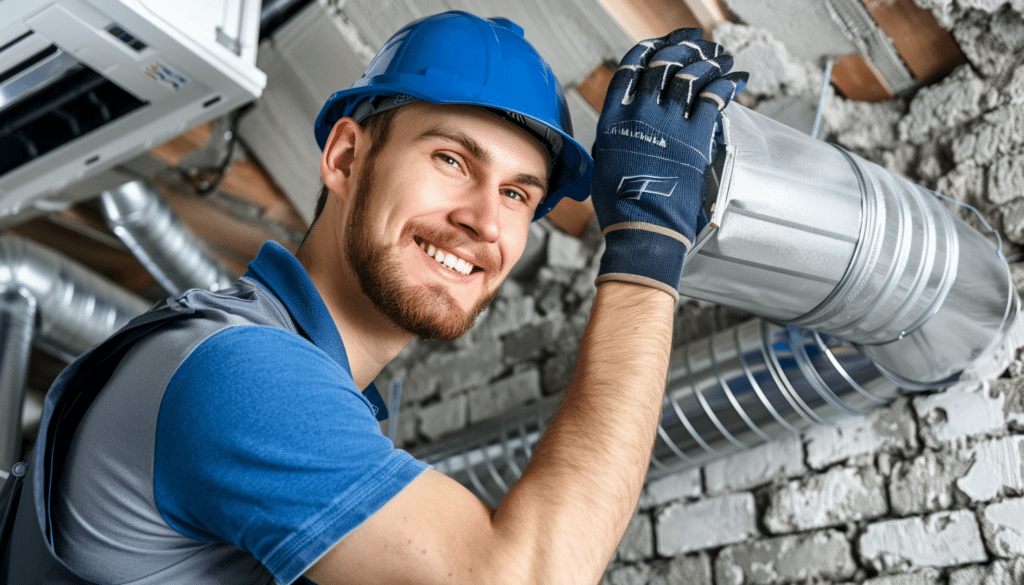Top Ductwork Installation Errors to Avoid
Ductwork is the silent hero of your HVAC system, ensuring efficient and consistent climate control throughout your home or business. However, even the most advanced HVAC units can fall short if paired with poorly installed ductwork. Ductwork Installation Errors can lead to inefficiencies, increased energy bills, and compromised comfort. This comprehensive guide will navigate through common pitfalls, ensuring your ductwork installation enhances your HVAC system’s functionality and your space’s comfort.
Understanding Ductwork Installation
Before discussing ductwork installation errors, it’s crucial to understand ductwork installation. Ductwork refers to the conduits that distribute air from your HVAC system throughout your building. Proper installation is paramount for optimal performance.

Common Ductwork Installation Errors to Avoid
- Ignoring Manual D Guidelines: The ACCA’s Manual D provides a detailed methodology for designing duct systems. Skipping this guide can result in inefficient designs that neither deliver air properly nor maintain desired temperatures efficiently.
- Neglecting Proper Sizing: Incorrect duct sizing can lead to pressure imbalances, poor air distribution, and HVAC system strain. Ensure duct sizing aligns with your space’s needs for efficient operation.
- Poor Sealing and Insulation: Leaks in ductwork can lead to significant energy loss. Proper sealing and insulation are crucial to prevent air from escaping, ensuring every bit of conditioned air reaches its intended destination.
Visualizing the Impact: A Comparative Table
To illustrate the significance of avoiding these errors, let’s consider a table comparing efficient vs. inefficient ductwork installation:
| Criteria | Efficient Installation | Inefficient Installation |
|---|---|---|
| Energy Consumption | Lower due to proper design and sealing | Higher due to leaks and poor design |
| Comfort Levels | Even temperature distribution | Hot and cold spots throughout the space |
| HVAC Lifespan | Longer, as the system operates under less strain | Shorter, due to increased and uneven workload |
Enhancing Your HVAC System’s Performance
Adhering to best practices in ductwork installation not only supports your HVAC system’s efficiency but also prolongs its lifespan and enhances indoor comfort. Here are steps to ensure a flawless setup:
- Consult a Professional: Always work with experienced technicians who understand the intricacies of ductwork installation.
- Regular Maintenance: Even the best-installed systems need check-ups to ensure they remain leak-free and well-insulated.
- Upgrade When Necessary: As your building or HVAC system changes, so do your ductwork needs. Be open to adjustments or upgrades.
Elevating Installation Standards
Continuing from the established groundwork on avoiding ductwork installation errors, the narrative now shifts towards elevating standards and practices to ensure every ductwork installation reflects quality, efficiency, and reliability. Achieving excellence in ductwork installation not only demands adherence to industry best practices but also a commitment to detail and precision that distinguishes superior work.

Advanced Considerations in Ductwork Installation
- Zoning Systems for Enhanced Comfort: Implementing zoning systems can drastically improve the comfort and efficiency of a space by allowing different areas to be heated or cooled independently based on need or occupancy.
- Innovative Materials and Techniques: The use of advanced materials and installation techniques can significantly reduce installation time, improve durability, and enhance system efficiency. Exploring options such as flexible ductwork or higher insulation values can lead to better outcomes.
The Role of Technology in Ductwork Installation
Technology has revolutionized how ductwork installations are planned, executed, and maintained. From software that aids in precise ductwork design to diagnostic tools that ensure optimal airflow and identify leaks, embracing technological advancements is key to modern, efficient installations.
Mitigating Noise and Enhancing Air Quality
- Noise Reduction Strategies: Properly designed ductwork can significantly reduce noise from air movement and system operation, contributing to a more peaceful environment.
- Air Quality Improvements: Beyond temperature control, ductwork plays a crucial role in maintaining indoor air quality. Incorporating filtration and purification systems within the ductwork can remove contaminants before they circulate through the living or working space.
Leveraging Professional Expertise
While the fundamentals of ductwork installation may seem straightforward, the nuances of a truly efficient and effective system lie in the expertise of professionals. Choosing the right contractor—one with a proven track record, necessary certifications, and a commitment to quality—is crucial.

Continuous Learning and Adaptation
The field of HVAC and ductwork installation is ever-evolving, with new materials, methods, and standards continually emerging. For professionals in the field, ongoing education and adaptation to these changes are non-negotiable for maintaining the highest quality of work.
Maximizing Your HVAC’s Potential Through Expert Ductwork Installation
Beyond just avoiding errors, the key to truly maximizing the potential of your HVAC system lies in recognizing the ductwork installation errors. This involves not only selecting the right materials and adhering to best practices but also understanding the unique needs of your space and how ductwork contributes to the overall efficiency and comfort of your environment.
Integrating Smart HVAC Technologies
The future of HVAC systems is smart technology. From thermostats that learn your preferences to systems that adjust airflow based on room occupancy, the integration of smart technologies with ductwork can significantly enhance efficiency and comfort. Here’s how:
- Smart Vents: These can open or close to redirect air as needed, improving comfort and reducing energy consumption.
- Air Quality Sensors: Integrated within the ductwork, these sensors can detect pollutants and adjust filtration settings automatically, ensuring optimal indoor air quality.
Sustainability in Ductwork Installation
Sustainability is becoming increasingly important in all aspects of construction, including HVAC and ductwork installation. Utilizing recyclable materials, ensuring systems are designed for maximum efficiency, and considering the lifecycle environmental impact are all crucial steps toward more sustainable HVAC solutions.
Case Studies: Learning from Success
Understanding the impact of expert ductwork installation is best illustrated through real-life examples. Case studies of homes and businesses that have undergone ductwork optimization reveal significant improvements in energy efficiency, cost savings, and occupant comfort, serving as a testament to the value of doing things right the first time.
The Wintri Experience: A Commitment to Excellence
Drawing from the comprehensive services and dedication of the Wintri team, it’s clear that a meticulous approach to ductwork installation pays off. By prioritizing customer satisfaction, continuous learning, and a commitment to quality, Wintri sets the standard for HVAC and ductwork excellence.

Future Trends in Ductwork and HVAC
As technology advances, so too do the possibilities for ductwork and HVAC systems. Future trends likely include more advanced smart technologies, greater emphasis on sustainability, and innovative materials and methods that further enhance efficiency and performance.
Engage and Transform: Your HVAC Journey Starts Here
As we conclude this exploration of ductwork installation and its pivotal role in HVAC efficiency, we invite you to take the next step in your HVAC journey. Whether you’re considering an upgrade, facing ductwork challenges, or simply aiming for optimal efficiency, engaging with experts like Wintri is your gateway to a comfortable, efficient, and satisfying environment.
FAQs
How often should ductwork be inspected?
Ideally, have your ductwork inspected every 3 to 5 years to catch any issues early.
Can I seal ductwork myself?
While minor seals can be a DIY project, professional sealing ensures comprehensive coverage and durability.
Does ductwork affect indoor air quality?
Absolutely. Well-sealed and clean ductwork minimizes dust and allergen distribution, enhancing air quality.
Can ductwork design impact energy bills?
Yes, significantly. Efficiently designed and installed ductwork minimizes energy loss, leading to lower energy bills.
How does ductwork contribute to HVAC efficiency?
Proper ductwork design and installation ensure optimal airflow and distribution, which is critical for the efficiency of the HVAC system.
Is it worth investing in high-quality ductwork materials?
Absolutely. High-quality materials can enhance durability, efficiency, and overall system performance.

